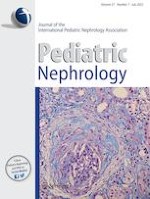27.01.2022 | Clinical Quiz
Joining the dots: Questions
Erschienen in: Pediatric Nephrology | Ausgabe 7/2022
Einloggen, um Zugang zu erhaltenExcerpt
A 6-year-old girl with E beta thalassemia on regular blood transfusion and iron chelation therapy was brought to the emergency room with vomiting for the previous 2 days, low grade temperature, and decreasing consciousness. On examination, her distal extremities were cool; she was pale, tachycardic, tachypneic, and had a Glasgow Coma Scale (GCS) of 9/15 without any meningeal signs. Initial investigations including arterial blood gas (ABG) are shown in Table 1. Subsequently, the child was stabilized with intravenous fluids and broad-spectrum antibiotics as well as acyclovir. Despite hemodynamic stabilization, her encephalopathy persisted and her repeat blood investigation at 8 h revealed worsening liver function tests and elevated ammonia (Table 1). Repeat ABG showed persisting metabolic acidosis despite improving serum lactate. Magnetic resonance imaging (MRI) of the brain was reported normal. Child responded well with ammonia-scavenging therapy with sodium benzoate (500 mg/kg/day) and other liver protective measures. Her GCS normalized by 48 h post-admission but metabolic acidosis, hypokalemia, and hypophosphatemia persisted. In addition, her urine dipstick was noted to be 2 + for proteinuria although blood sugar was absent. Her spot urinary protein creatinine ratio (UPCR) was elevated.|
Investigations at admission
|
Investigation at 8 h
|
Investigation at 48 h
|
|
|---|---|---|---|
|
Arterial blood gas
|
pH 7.19, pCO2 28 mmHg, pO2 115 mmHg, HCO3 8 mmol/l, BE − 16 mmol/l, BE 132 mmol/l, Cl 107 mmol/l, K 2.5 mmol/l, iCa 0.8 mmol/l, lactate 10.2 mmol/l
|
pH 7.28, pCO2 31 mmHg, HCO3 11 mmol/l, BE − 13 mmol/l, Na 133 mmol/l, Cl 115 mmol/l, K 2.8. mmol/l, Ca 0.89 mmol/l, lactate 7.4 mmol/l
|
pH 7.31, pCO2 35 mmHg, pO2 108 mmHg, HCO3 14 mmol/l, BE − 11 mmol/l, Na 132 mmol/l, Cl 114 mmol/l, K 3.0 mmol/l, Ca 1.0 mmol/l, lactate 2.2 mmol/l
|
|
Serum sodium
|
134 mEq/l
|
136 mEq/l
|
139 mEq/l
|
|
Serum potassium
|
2.8 mEq/l
|
3.1 mEq/l
|
3.24 mEq/l
|
|
Serum chloride
|
111 mEq/l
|
121 mEq/l
|
118 mEq/l
|
|
Serum phosphate
|
3.2 mg/dl
|
NA
|
2.8 mg/dl
|
|
Serum albumin
|
2.8 gm/dl
|
NA
|
3.1 gm/dl
|
|
Serum creatinine
|
1.2 mg/dl
|
1.3 mg/dl
|
1.5 mg/dl
|
|
ALT
|
333 U/l
|
368 U/l
|
448 U/l
|
|
AST
|
295 U/l
|
315 U/l
|
405 U/l
|
|
INR
|
NA
|
NA
|
1.4
|
|
Prothrombin time
|
NA
|
NA
|
19.7 s
|
|
Hb/ TLC (N %) / platelet
|
10.5 gm/dl/ 5900 /mm3, N46, L51%, 94,000/mm3
|
10.2gm/dl, 5700/mm3, N40, L58%, 92,800/mm3
|
9.5 gm/dl, 4670/mm3, N47, L49%, 84,600/mm3
|
|
Spot UPCR
|
NA
|
NA
|
1.7 gm/gm of creatinine
|
|
Serum ammonia
|
NA
|
406 mcg/dl
|
170 mcg/dl
|











